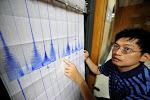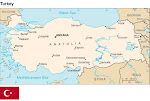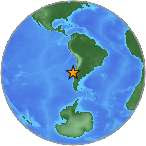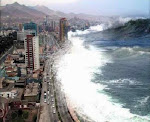 PARIS-[[[A powerful volcano erupted under the icesheet of West Antarctica around 2,000 years ago and it might still be active today, a finding that prompts questions about ice loss from the white continent,]]]British scientists report on Sunday.The explosive event-rated "severe" to "cataclysmic" on an international scale of volcanic force-punched a massive breach in the icesheet and spat out a plume some 12,000 metres (eight miles) into the sky, they calculate.Most of Antarctica is seismically stable. But its western part lies on a rift in Earth's crust that gives rise to occasional volcanism and geothermal heat, occurring on the Antarctic coastal margins.This is the first evidence for an eruption under the ice sheet itself-the slab of frozen water, hundreds of metres (feet) thick in places, that holds most of the world's stock of fresh water.Reporting in the journal Nature Geoscience, the investigators from the British Antarctic Survey (BAS) describe the finding as "unique."It extends the range of known volcanism in Antarctica by some 500 kilometres (300 miles) and raises the question whether this or other sub-glacial volcanoes may have melted so much ice that global sea levels were affected, they say.The volcano, located in the Hudson Mountains, blew around 207 BC, plus or minus 240 years, according to their paper.Evidence for this comes from a British-American airborne geophysical survey in 2004-5 that used radar to delve deep under the ice sheet to map the terrain beneath.Vaughan's team spotted anomalous radar reflections over 23,000 square kilometres (8,900 sq. miles), an area bigger than Wales.They interpret this signal as being a thick layer of ash, rock and glass, formed from fused silica, that the volcano spewed out in its fury.The amount of material-0.31 cubic kilometres (0.07 cubic miles)-indicates an eruption of between three and four on a yardstick called the Volcanic Explosive Index (VEI).By comparison, the eruption of Mount St. Helens in 1980, which was greater, rates a VEI of five, and that of Mount Pinatubo in 1991 is a VEI of six."We believe this was the biggest eruption in Antarctica during the last 10,000 years," BAS' Hugh Corr says."It blew a substantial hole in the icesheet and generated a plume of ash and gas that rose around 12 kms (eight miles) into the air."The eruption occurred close to the massive Pine Island Glacier, an area where movement of glacial ice towards the sea has been accelerating alarmingly in recent decades."It may be possible that heat from the volcano has caused some of that acceleration," says BAS professor David Vaughan, who stresses though that global warming is by far the greater likelier cause.Volcanic heat "cannot explain the more widespread thinning of West Antarctic glaciers that together are contributing nearly 0.2mm (0.008 of an inch) per year to sea-level rise," he adds."This wider change most probably has its origin in warming ocean waters."
PARIS-[[[A powerful volcano erupted under the icesheet of West Antarctica around 2,000 years ago and it might still be active today, a finding that prompts questions about ice loss from the white continent,]]]British scientists report on Sunday.The explosive event-rated "severe" to "cataclysmic" on an international scale of volcanic force-punched a massive breach in the icesheet and spat out a plume some 12,000 metres (eight miles) into the sky, they calculate.Most of Antarctica is seismically stable. But its western part lies on a rift in Earth's crust that gives rise to occasional volcanism and geothermal heat, occurring on the Antarctic coastal margins.This is the first evidence for an eruption under the ice sheet itself-the slab of frozen water, hundreds of metres (feet) thick in places, that holds most of the world's stock of fresh water.Reporting in the journal Nature Geoscience, the investigators from the British Antarctic Survey (BAS) describe the finding as "unique."It extends the range of known volcanism in Antarctica by some 500 kilometres (300 miles) and raises the question whether this or other sub-glacial volcanoes may have melted so much ice that global sea levels were affected, they say.The volcano, located in the Hudson Mountains, blew around 207 BC, plus or minus 240 years, according to their paper.Evidence for this comes from a British-American airborne geophysical survey in 2004-5 that used radar to delve deep under the ice sheet to map the terrain beneath.Vaughan's team spotted anomalous radar reflections over 23,000 square kilometres (8,900 sq. miles), an area bigger than Wales.They interpret this signal as being a thick layer of ash, rock and glass, formed from fused silica, that the volcano spewed out in its fury.The amount of material-0.31 cubic kilometres (0.07 cubic miles)-indicates an eruption of between three and four on a yardstick called the Volcanic Explosive Index (VEI).By comparison, the eruption of Mount St. Helens in 1980, which was greater, rates a VEI of five, and that of Mount Pinatubo in 1991 is a VEI of six."We believe this was the biggest eruption in Antarctica during the last 10,000 years," BAS' Hugh Corr says."It blew a substantial hole in the icesheet and generated a plume of ash and gas that rose around 12 kms (eight miles) into the air."The eruption occurred close to the massive Pine Island Glacier, an area where movement of glacial ice towards the sea has been accelerating alarmingly in recent decades."It may be possible that heat from the volcano has caused some of that acceleration," says BAS professor David Vaughan, who stresses though that global warming is by far the greater likelier cause.Volcanic heat "cannot explain the more widespread thinning of West Antarctic glaciers that together are contributing nearly 0.2mm (0.008 of an inch) per year to sea-level rise," he adds."This wider change most probably has its origin in warming ocean waters."As in the days of Noah....



















.jpg)


.bmp)
No comments:
Post a Comment